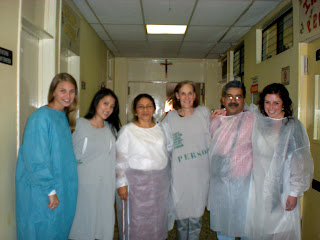One thing that struck us was Lorenzo's commitment to bringing the positive effects of macadamia trees to other parts of the world. He has currently planted 500,000 trees and his goal is to plant 5 million worldwide. The farm's motto is: "Let's make planet earth our church and protecting it our religion." Each visit to the macadamia farm contributes to this goal. Please check out their website for more details: www.exvalhall.net
 |
| Lorenzo and the team |
Our next stop was to the Hospital Nacional Pedro de Bethancourt, a public hospital in Antigua. We met with Dr. Waldemar Guerra, the head of pediatrics. One of his main concerns was the lack of reliable diagnostic tools. The small number of tests that can be performed by local laboratories may not even give accurate results. He also spoke of the current internship program with medical students from Baylor College of Medicine, who come to Guatemala for 2 months to work in the hospital. He says that he learns a great deal from these students and envisions the possibility for genetic counselors to do a similar program. He believes that genetic counselors are needed "in the battlefield" and that health care in Guatemala should focus both on genetics and infectious disease - one should not take precedence over the other. Dr. Guerra also described the Participant Mother Program that encourages mothers to stay with their children in the hospital while they are treated, to breast feed and care for them. The mothers are also given lectures each day by physicians, nurses, social workers, psychologists, and nutritionists, centered around breast feeding, rehydration/diarrhea, bronchial infections, and vaccines. We had the opportunity to tour the facility and meet some of the mothers and patients, while learning about how the hospital operates. The pediatric intensive care unit was particularly emotional for each of us, due to the critical state of the patients. We further met with a head nurse to discuss the current treatment of patients with genetic conditions and the education and role of nurses in the hospital.
 |
| With Dr. Guerra before entering the ICU |
Finally, we headed back to Guatemala City for a meeting with the board of directors of Colegio de Medicos y Cirujanos de Guatemala. They are the governing body for all of the doctors in Guatemala, who must register with them before practicing medicine. We discussed our project in detail and asked many questions about the current education of health care professionals, prevalent genetic conditions, existing public health programs, and active research projects. The board recommended people for us to get in touch with to achieve 3 goals: 1) perform research to identify the most prevalent genetic conditions in Guatemala, 2) train doctors to diagnose these genetic conditions, 3) train genetic counselors to speak with those diagnosed and their families. At the end of the meeting the board granted us their support with our efforts in Guatemala and offered their assistance in the future.

Well done! Congratulations to you all!
ReplyDelete